Safety
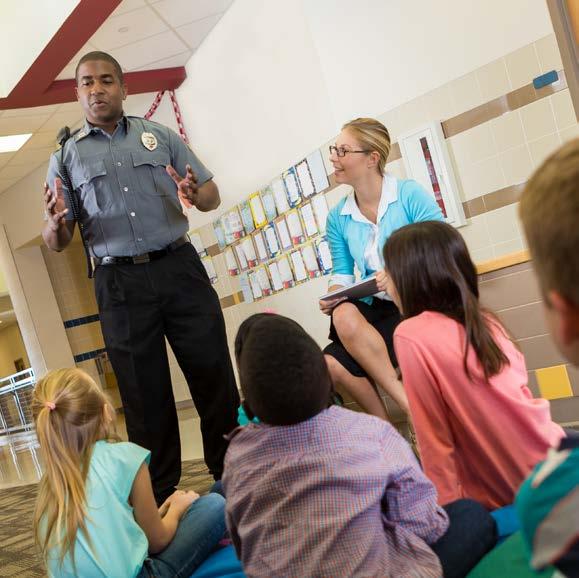
MARCH 2023 ■ VOLUME 25 ■ NUMBER 3
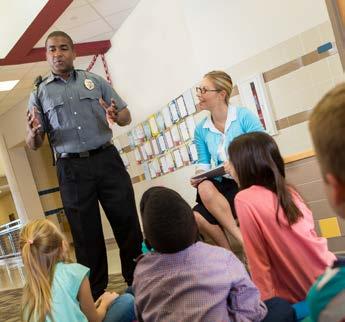
Return to Table of Contents EDITORIAL BOARD MEMBERS Tiffany Barrett Keith Burke Rick Hunt Nicholas Mitchaner Dan Peo Steve Samuel Kelly Storms 11025 East 25th Street Indianapolis, IN 46229 1-800-285-2188 or 317-891-9900 www.iasp.org tbarrett@iasp.org © 2022 Indiana Association of School Principals All rights reserved. Any duplication without prior written permission is strictly prohibited. The Indiana Association of School Principals leads in the advocacy and support of all principals in their commitment to every child. Connect with us MARCH 2023 ■ VOLUME 25 ■ NUMBER 3 TABLE OF CONTENTS President’s Letter - Safety ................................................ 3 IDOE - Safety in the Digital Age ........................................... 6 From the AP Lens: Keeping a Focus on School Safety ...................... 8 SAFETY Kick up your school safety lessons! ......................................12 Infinite Capacity Community Partnership Series: Student and Educator Safety in STEM/STEAM Learning Environments ....................16 LEADERSHIP DEVELOPMENT School Safety Trends In The United States: A Shift Toward Proactive, Non-Hardened Approaches ........................................20 Meeting the Needs of Small/ Rural High Schools: The Rural Early College Network ...................................................23 IPLI Updates............................................................26 SERVICE Riley Kids Caring & Sharing Update .....................................27 LEGAL REVIEW KGR Law Briefing: Special Education Law Developments.................28 Safety
Fire Drills. Tornado Drills. ALICE drills. Man-made disaster drills. When I was in elementary school, I remember earthquake and atomic bomb drills, too. When considering school safety, we often think about the myriad of preparation drills we schedule and conduct each school year in hopes that we never have to experience these situations, and in most cases, we do not. Then, there are those unexpected situations that occur when we have to rely on our leadership instincts and experience to respond in an immediate yet prudent manner. These events may impact the entire school or involve a single student. Whatever the case, we quickly jump in to handle it and then move on to the next fire that arises.
You have likely noticed that each issue of the Indianagram has a particular theme, and the March issue focuses on safety. When considering this theme and the aforementioned scenarios, one final step we may unintentionally neglect as school leaders is reflecting on or debriefing how effective our response was to a given scenario.
Recently, I pulled together my administrative team to debrief a sensitive student issue we handled that involved administrators, SROs, local police and an outside service provider. The “many hands in the pot” further complicated an already difficult situation. After getting my team’s initial impressions, I met with our school police chief and district safety coordinator to share my team’s reflections. I used that meeting to lay the groundwork for another meeting with my team that would involve the chief and coordinator to offer guidance and feedback for the future. At the last team debriefing, we had productive conversations focusing on solutions, producing better protocols and clarifying roles and responsibilities.
We want our teachers to reflect on their practices because we know it leads to better instruction and outcomes for our students. As school leaders, we must commit to reflecting and debriefing safety situations to ensure that our response is as efficient and effective as possible. This practice is not only critical after major events but is also warranted after the regular drills conducted in our buildings. A single idea or solution generated from a debrief might just be the difference for maintaining a culture of safety in our schools.
Regarding IASP matters, I am happy to share that we have some natural transition on the IASP Executive Committee that can only be viewed as positive. We welcome one newcomer and two individuals renewing their terms. Please join me in congratulating Jennifer Matasovsky, principal of Franklin Central High School, who will serve next year as Vice-President of IASP. Please also welcome back Dave Strouse, principal of Batesville Middle School, and Dan Peo, assistant principal at Avon High School, who will continue serving as the NASSP State Coordinator and Assistant Principal Liaison, respectively.
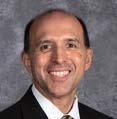 Matt Shockley IASP President
Matt Shockley IASP President
Return to Table of Contents
PRESIDENT’S LETTER 3 www.iasp.org
Safety
School safety is a topic that we always have in the back of our minds as we walk our hallways and as we monitor events, likely you carry this with you even as you leave the building each day. I know I still think about available exits and the behavior of people who are in the immediate area even though I’ve been out of the school building for over 15 years now! We also know that school safety is the issue that may need more attention given community or school circumstances, and in those times, your training and your understanding of what students and staff need to know to be safe kicks in. Sometimes this means immediate action and you follow your school safety plan and protocols. In other instances, you implement communication to the staff that ensures they have the knowledge they need for the situation, and then you take proactive steps to determine any further necessary actions or communication to parents and your central office. As you read President Matt Shockley’s article, you can see how he helped his school and district by also reflecting on what occurred and how they could improve their practices. The key element through all this is that school safety takes all of us, and your leadership allows students and staff to feel secure each time they enter your school or attend an event.
The School Leader Paradigm also captures these thoughts by stressing Safety as one dimension of the Systems Domain. As you refer to page 28 of the Paradigm, you’ll note that Safety is broken down into three areas: Leading a Culture of Safety, Managing Crises and Emergency Planning, and Assessing Threats. Further, each of these provides Essential Behaviors that any school should have firmly in place. By reviewing these with your school leadership or school safety team, you can conduct a mini audit of your school environment and safety plan, and then take the necessary steps to further bolster your practices. These best practices incorporate your learning environment, collaborative leadership, and essential training that allows you to integrate your safety plan document into daily thoughts and practices of all staff. Then, as you walk the hallways, and school safety arises in your mind, you will know that your leadership has the students and staff in a safe and secure environment.
We wish all of you the best during this Springtime and hope that your Spring Break provides the necessary time to recharge for the last push to the end of the school year. Likely more than a few of you are catching up on some “school” work, and we understand this! Just be sure to also catch up on some “You” work, this investment will keep you in the right mindset to tackle current and new challenges.
Dr. Todd D. Bess
IASP Executive Director
Future Indianagram themes

Matt Shockley President

Dr. Crystal Murff Thorpe President-Elect
Dr. Holly Arnold
Vice President
Aimee Lunsford
Past President
Amy Niemeier
NAESP State Representative
Dave Strouse
NASSP State Coordinator
Steve Baker
Liaison to the DOE
Dr. Daniel Peo
Assistant Principal Liaison
Return to Table of Contents
Data Literacy April 2023 Social Media May 2023 Best of 2022-23 June 2023 Share your thoughts on the Indianagram https://forms.gle/sCmLHwnh4aYcTJdr8
IASP Executive Committee
FROM THE EXECUTIVE DIRECTOR 4 www.iasp.org
UPCOMING EVENTS
IASP hosts events throughout the year to support the growth and development of Indiana school administrators and students. Each event is intentionally designed to encourage and engage all participants in the pursuit of learning!
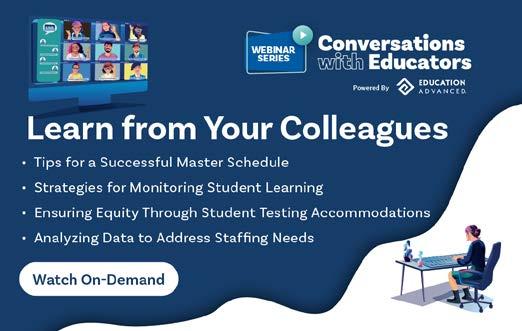
Find A Full List Of Events at www.iasp.org/Events
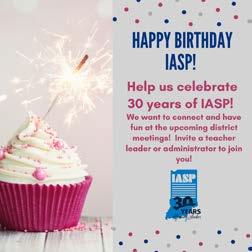
Return to Table of Contents
Special thanks to our Platinum Corporate Sponsor
5 www.iasp.org
Safety in the Digital Age
 Dr. Katie Jenner Indiana Secretary of Education
Dr. Katie Jenner Indiana Secretary of Education

Just last week I spoke to several school and district leaders about tornado warnings in their area–and in several cases, we had confirmed tornadoes touch down. Welcome, March…when the weather is often unpredictable… ranging from tornadoes one week to snow the next. Despite this uncertainty, it’s always nice to get through the first couple months of the year (often considered the long months for educators) and look forward to spring break!
As school leaders, we wear many hats. In addition to supporting teachers, and of course, students as they develop the foundational knowledge and skills, we are also responsible for building the teams necessary to protect our students and keep them safe. For some students, our schools provide a safe haven. These feelings of safety and security are essential to a child’s ability to grow and thrive, both personally and academically…and we know this takes a village.
As I’m sure you can all attest, many staff hours are spent developing and implementing school safety and emergency preparedness plans for our Indiana schools – this is often top of mind when we think of the “traditional” definition of school safety. In addition to
these plans, in Indiana, it is required by law for every school corporation to have a school safety specialist on staff, and through state and local collaboration, we have far surpassed that requirement!

Through Indiana’s nationally recognized School Safety Specialists Academy, our school safety officials receive the most up-to-date, pertinent information on state and national best practices surrounding school safety, security, intervention/prevention, emergency preparedness, and more. Indiana’s school safety officials also have access to a number of virtual and in-person training opportunities throughout the state which can be found on IDOE’s website
As many of you know, the state also provides financial support to eligible schools to purchase new equipment or hire additional safety staff. To date, the Secured School Safety Grant (SSSG) Program has awarded more than $133 million in matching grants to Indiana schools across the state to address potential safety threats and help maximize school preparation. To see if your building may qualify, click here!
Some of you may also know that I am a mom to twin teenage girls, and their safety is always top of mind for me… whether they’re going to and from
school or just browsing the internet at home. As technology usage becomes more and more prevalent in our students’ instruction, it’s also more important than ever that we ensure our students are equipped with the proper digital safety and digital literacy safeguards when using the internet.
Improving digital literacy has been at the forefront of our work and is even one of the five characteristics elevated through the Indiana Graduates Prepared to Succeed (Indiana GPS) dashboard framework. For the first time ever, IDOE’s Digital Learning Grant has a strand specifically dedicated to increasing awareness of digital literacy, and schools may use these funds to support skill development in areas such as digital citizenship, digital collaboration, digital design, and more. Applications for the Digital Learning Grant are open through Friday, March 24, so be sure to get your applications in soon!
Our students are our future, and in today’s world, while safety can take on many different meanings, we must remain diligent. I am increasingly grateful for each of you, and for all that you do to keep our Indiana students safe each and every day.
Return to Table of Contents
6 www.iasp.org
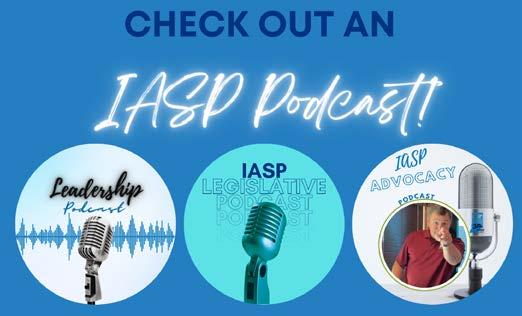

Return to Table of Contents 7 www.iasp.org
From the AP Lens: Keeping a Focus on School Safety
Dr. Dan Peo Assistant Principal Avon High School IASP Assistant Principal Liaison
 Mr. Ryan Welch Principal Menominee Elementary School
Mr. Ryan Welch Principal Menominee Elementary School
School safety is a topic that has become much more important in the years since the tragedy at Columbine High School in 1999. Keeping safety in mind has changed many of the things that we do in our daily school lives. When I first started teaching, I didn’t think twice about propping a door open for an after-school band rehearsal; now, we routinely panic when we see doors propped open or we notice other things that on their face might not be dangerous. As Assistant Principals, safety is one of the first things we need to provide in order for students to be able to learn. Safety is also important for the many adults who serve our students and each other in our schools. I am grateful that Indiana is one of the states that is on the forefront of school safety, and our School Safety Specialist Academy has been training school officials for over twenty years. If you haven’t taken advantage of this incredible resource, I would invite you to do so: https://www.in.gov/doe/students/schoolsafety-and-wellness/training-opportunities/
This month, I’ve asked my colleague Mr. Ryan Welch, Principal at Menominee Elementary School (and former IASP AP of the Year), to share some of his experiences with ensuring safety in his school buildings.

School Safety: Priority Number One
If you polled parents across the state of Indiana and asked them what they want from their local school districts, you would hear answers ranging from academic growth, social growth, quality intervention, college prep, counseling supports, offerings of extracurriculars and a variety of other necessary items that are ingrained in all of our schools. Along with these priorities is what I believe to be the most important component of any school, and that is school safety. According to Corey DeAngelis, “Families care about their children’s safety and would not voluntarily send their children to schools they perceive as unsafe.” What is problematic is that when parents need to change schools that they are assigned to, often there is a cost. Every parent wants their child to be in a safe environment. How do schools do it?
Schools are not created with cookie cutters, so every schools’ safety plans are different. In our world of education, we are in
the people business, so you have to adapt those safety plans, based on the needs of your community and student body, year after year. No matter the need, you can never be too prepared.
As a school administrator, school safety and student safety are the priority. How can a student learn if they don’t feel safe? Of course, as all schools do, we plan and execute our monthly drills and our students and staff know what key phrases and sounds from certain alarms mean. However, school safety is more than that. School safety is looking after the emotional, physical, and mental wellbeing of all of our students every moment they are in our care.
As a school leader, how do we ensure that students know what the ideal safe environment of a school is? Sure, every school goes through their set of rules and if you were to compare schools around the state, we would see many commonalities. However, despite saying the rules, do we actually teach the rules and give a deeper understanding that all of our rules are in place because of learning and safety? The challenge occurs when this “ideal safe environment” does not match the students’ world outside of the school day. Just like the other subject areas, do we teach what the ideal safe environment is? What does it look like? When a student does not meet the expectation of the ideal safe environment, do we consider what a second tier of instruction looks like, or do they just get in trouble? Does the consequence help the student to understand what the expectations are?
According to Blair Ames, from the National Institute of Justice, “Nearly 100% of schools serving 12 to 18 years olds use at least one safety or security measure. This includes locked doors, security cameras, hallway supervision, controlled building access, metal detectors, and locker checks.” However, with these necessary protocols in place, there still needs to be a continued focus and effort from all schools for the wellbeing and safety of all students and staff. This is an endeavor that faces us every hour of every day. Generally, these safety precautions are not recognized by those outside of the school. It is the norm, it is what is expected. I know it takes effort, courage, focus and diligence every day to ensure that these
Return to Table of Contents
ASSISTANT PRINCIPAL
CONNECTION
8 www.iasp.org
safety measures are in place. So from one principal to every school personnel in charge of overseeing the safety of our students, I thank you!
Whose responsibility is it? The saying “It takes a village to raise a child” comes to mind here. The safety of our students is the responsibility of all school personnel. Often our school counselors and social workers are the ones who get called upon to restore relationships and support students, but that is not enough. It takes every individual, from the support aide to the secretary and school principal to ensure that a student feels safe, is safe, and is cared for. Thus far, I haven’t mentioned a key player in this model and that is the student. Does your school have the systems in place for students to report to adults when there is a concern regarding safety? Do students have the web of support to know that they have caring individuals who show up everyday for them? Again, this is something that has to continue to evolve and grow every day. Our students deserve it!
School Safety is more than the set of rules that are posted in the classrooms and the locked door entering the building. School safety is about the relationships among staff to students to families. It is about the process of teaching students what a safe environment is and looks like. It is about communicating with necessary stakeholders. School safety is about a level of focus
and determination that we are constantly seeking to improve. It is about constant collaboration with other school leaders, law enforcement and community leaders so that resources are adequately accessible for all.
School safety can be a daunting task for any one individual. Fortunately, it is not the responsibility of one individual. It is the responsibility of all. Our students are deserving of coming to school and knowing that they are loved and cared for. They deserve the policies and protocols that keep their wellbeing a priority. I thank you for your continued effort in promoting a safe environment for the students and communities you serve!
Mr. Welch can be reached via email at rwelch@plymouth.k12. in.us.
References
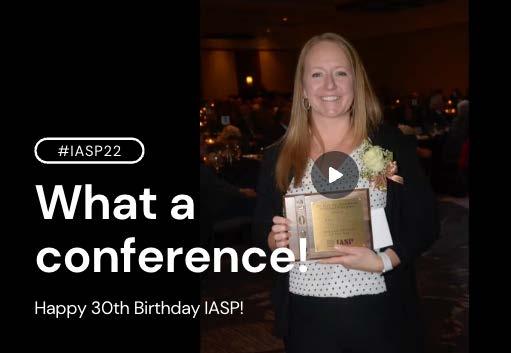
Ames, Blair. “Making Schools Safe for Students.” National Institute of Justice, 3 June 2019, nij.ojp.gov/topics/articles/making-schools-safe-students. Accessed 15 Feb. 2023.
DeAngelis, Corey. “An Analysis of K-12 Student Safety Policies and School Climates in Indiana.” Reason Foundation, 10 Oct. 2019, https://reason.org/ policy-brief/analysis-of-k-12-student-safety-policies-and-school-climates-inindiana. Accessed 15 Feb. 2023.
Return to Table of Contents
ASSISTANT PRINCIPAL CONNECTION 9 www.iasp.org


Return to Table of Contents GAME-CHANGING LEADERSHIP WEARS BLUE FOR MORE INFORMATION, PLEASE VISIT INDSTATE.EDU/BLUELEADS. EARN YOUR ED.S. IN SCHOOL ADMINISTRATION The program features courses designed for busy school leaders, taught by K-12 experts. Related degree programs include M.Ed. in School Administration & Supervision and Ph.D. in Educational Administration. CONTACT US AT 812-237-8624 or Ryan.Donlan@Indstate.edu. edleadership ad_poc.indd 1 2/28/23 3:53 PM 10 www.iasp.org
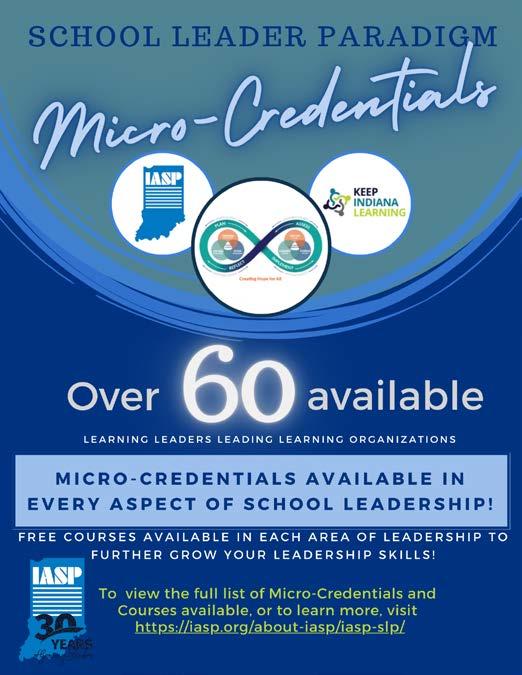
Return to Table of Contents 11 www.iasp.org
Kick up your school safety lessons!
Dr. Traci Blaize Principal Lakeland Primary School, LaGrange, IN

We have all sat in “that” training, right? It might even be fair to say most of us have been in charge of “that” training. You know, the training that nobody really wants to be at. The training no one thinks applies to them. As a building principal, I often felt that the school safety portions of my trainings, staff meetings, collaborations, etc might be “that” meeting. When I became our school corporation’s safety coordinator I wanted to ensure consistent training across all buildings, and I didn’t want it to be boring. In our past model, the building principal decided what to cover and how to cover a topic; we sent our schedule to the coordinator and checked off a box.
While I was contemplating this, I was also learning more about digital teaching. We were making our first foray into virtual learning at the time, so I was digging deep and trying to keep up with my staff! I came across information about hyperdocs. A hyperdoc is an electronically organized template for a lesson. It goes back to the roots of good teaching: have a hook to get students interested, give them some information, have them work independently, work in some collaboration and assess. There are many hyperdoc templates out there, I chose one from Creative Commons Driving Digital Learning to start my school safety adventure with, and I have stuck with it. Let’s do a quick walk through of a lesson.

Return
SAFETY
to Table of Contents
12 www.iasp.org
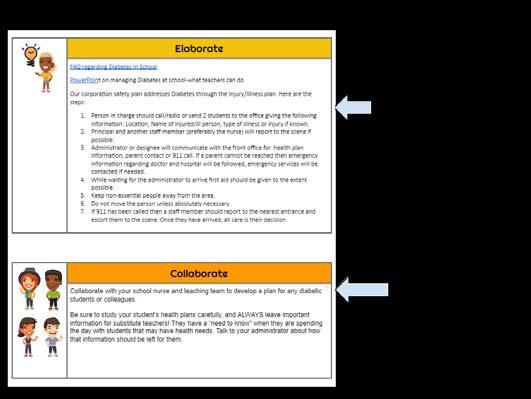

SAFETY 13 www.iasp.org

Return to Table of Contents Whether you’re an experienced veteran principal, aspiring principal, or new to the profession, the NAESP Pre-K–8 Principals Conference will help you develop leadership skills to become a more effective leader, offering 100+ breakout sessions, unique learning experiences, and opportunities to grow your network with your peers. The conference will be held at the Gaylord National Resort and Convention Center in National Harbor, Maryland. With gorgeous views of the Potomac River, restaurants, shopping, and monuments and attractions nearby in our nation’s capital, there is something for everyone to enjoy. To register visit naespconference.org 800-386-2377 • naesp.org • twitter.com/naesp • facebook.com/naesp • instagram.com/thenaesp • linkedin.com/company/naesp National Association of Elementary School Principals Serving all elementar y and middle-level principals Ready to level up your leadership skills? 14 www.iasp.org
Principal in Balance: Leading at Work and Having a Life









Return to Table of Contents Learn more and register at naespconference.org 800-386-2377 • naesp.org • twitter.com/naesp • facebook.com/naesp • instagram.com/thenaesp • linkedin.com/company/naesp National Association of Elementary School Principals Serving all elementar y and middle-level principals
Houston Kraft Co-founder, CharacterStrong
Joanne McEachen CEO and Founder of the Learner First
Freeman A. Hrabowski, III President Emeritus of University of Maryland, Baltimore County Todd Nesloney Director of Culture & Strategic Planning, Texas Elementary Principals and Supervisors Association
KEYNOTE SPEAKERS PRE-CONFERENCE WORKSHOPS*
a Culture That Lasts
to Promote Teacher Retention
C.E.O.,
A Framework for Equity Leadership Design
Dr. Tyler Cook Principal, Klein Elementary
Creating
What Administrators Can Do
Adam Saenz, Ph.D.
Applied EQ Group
Andrea Dixon-Seahorn, Ed.D Chief Equity Officer, Liberty Public Schools
Jessica Cabeen
15 www.iasp.org
Principal, Austin Online Academy, NAESP Fellow *Pre-conference workshops take place on July 9 and have an additional fee.
Infinite Capacity Community Partnership Series: Student and Educator Safety in STEM/STEAM Learning Environments
Krista M. Stith Infinite Capacity, LLC
Rachel L. Geesa Infinite Capacity, LLC


The report released in 2022 by the International Technology and Engineering Educators Association, A National Report STEM Education Imperative: What the Data Tells Us (Love & Roy, 2022), provides some startling safety statistics regarding science, technology, engineering and mathematics (STEM) and career and technical education (CTE) classrooms. Some of these statistics from Love and Roy (2022) include:
■ Within the last five years, 85% of participating schools reported accidents, and 77% of those accidents were student injuries (e.g., burns, cuts, fall hazards). Hot glue guns and improper use of equipment or portable power tools were the most common safety incidents.
■ Seventy-five percent of the participating schools reported an absence of 3D printer ventilation systems, despite emerging research on hazardous levels of ultrafine particles (UFPs) emitted from desktop 3D printers.
■ Most of the participating teachers noted that they did not require students to sign a safety acknowledgement form, pass safety tests for the use of equipment, use safety glasses/goggles, secure long hair/loose clothing/loose jewelry, or wear close-toed shoes.
■ Forty-seven percent of educators did not believe they had an adequate budget to follow safety protocols (e.g., equipment upgrades, PPE, safety training).
By taking student safety seriously in STEM and CTE classrooms, schools can create an environment where students can learn, explore, and create without fear of harm to physical health and well-being. Educators should be mindful of the following possible risks:
■ Physical safety: STEM and CTE classrooms typically involve the use of tools, machinery, and materials that can potentially cause bodily harm if misused.
- Chemical hazards: Improper handling and storage of chemicals and solvents can pose a health risk.
- Dust and fumes: Woodworking, metalworking, and soldering can produce hazardous dust and fumes.

- Ergonomics: Repetitive motions, awkward postures, and heavy lifting can cause musculoskeletal injuries.
- Fire: Improper use of tools and materials, as well as flammable substances, can pose a fire hazard.
- Electrical hazards: Exposed wires, frayed cords, and faulty electrical equipment can pose a shock or fire risk.
- Moving parts: Moving machinery and tools can cause entanglement and crush injuries.
- Noise: Loud machinery and tools can cause hearing damage.
- Sharp objects: Tools, such as saws, knives, and drill bits, can cause cuts and puncture wounds.
- Stored energy: Tools and machinery with stored energy, such as compressed air or spring-loaded devices, can cause injury if released unexpectedly.
- Unsecured equipment: Loose or poorly secured equipment can pose a risk of falling or tipping over.
■ Health and wellness: Certain materials and substances used in STEM and CTE classrooms can pose a risk to students’ health and well-being.
■ Legal and ethical responsibility: Schools and educators have a legal and ethical responsibility to provide a safe learning environment for students.
■ Negative learning experience: A safe and secure environment can help students feel confident and engaged, enabling them to focus on the learning experience and achieve their full potential. An unsafe environment could lead to a negative learning experience.
■ Negative school wide consequences: Accidents and injuries can result in lawsuits, lost instructional time, and negative impacts on the school’s reputation.
Steps to Minimize Possible Risks
Here are ten steps educators can take to minimize risks to student safety in STEM and CTE classrooms:
1. Conduct a hazard assessment: Identify potential hazards and assess the risk level.
2. Develop and enforce safety rules: Establish clear rules and procedures for using tools and equipment, handling materials, and responding to emergencies.
3. Provide training: Train students on the safe use of tools and equipment, as well as on emergency procedures.
4. Maintain equipment: Regularly inspect and maintain
Return to Table of Contents
SAFETY 16 www.iasp.org
equipment to ensure it is in good working condition.
5. Use personal protective equipment: Encourage students to wear protective equipment, such as safety glasses, earplugs, and gloves, as appropriate.
6. Store materials safely: Store flammable, hazardous, or toxic materials in designated areas and label them appropriately.
7. Supervise students: Closely supervise students, especially during the first few times they use new tools and equipment.
8. Post emergency information: Clearly post emergency information, such as the location of fire extinguishers and first-aid supplies.
9. Establish procedures for reporting incidents: Encourage students to report any accidents or incidents immediately.
10. Continuously review and update safety procedures: Regularly review and update safety procedures to ensure they are effective and relevant.
By taking these steps, educators can create safe and effective STEM and CTE environments for students to learn, explore, and create.
Resources
If your school’s STEM/STEAM or CTE program needs additional support to position the school for minimizing risks, please reach out to the following sources of information on STEM/STEAM safety.
■ Indiana Department of Labor: This department may have information and resources on workplace safety, including science labs. The department also has resources and information on workplace safety, including hazard assessments.
■ Indiana Occupational Safety and Health Administration (IOSHA): IOSHA is responsible for promoting and enforcing safety standards in the workplace, including science labs. IOSHA offers consultation services for workplace safety, including hazard assessments.
■ Schools and universities: Educational institutions may have science departments or programs that partner with local schools to provide resources and support for laboratory safety. Many universities also provide resources online, such as:
- Harvard Environmental Health & Safety (https://www.ehs.harvard.edu/programs/makerspacesafety)- Access to fact sheets, checklists, and equipment guidelines;
- University of Washington Environmental Health & Safety (https://www.ehs.washington.edu/workplace/shopand-maker-space-safety)- Access to templates, guides,
and checklists; and
- University of Nevada, Reno Innovation Center (https://www.unr.edu/innevation/makerspace/safety)Access to examples of basic makerspace safety.
■ Science and engineering organizations: Professional organizations, such as the American Chemical Society, the National Science Teachers Association or the National Institute for Occupational Safety and Health, may have resources and connections to local partners.
■ Industry associations: Organizations, such as the Indiana Biotechnology Association or the Indiana Chamber of Commerce, may have connections to companies and organizations that focus on laboratory safety. American Society of Safety Professionals may have local chapters in Indiana that can provide resources and support for hazard assessments.
■ Local government agencies: City and county health departments, as well as fire departments, may have resources and partnerships related to laboratory safety. They may have resources and expertise on fire safety and can assist with a hazard assessment.
■ Non-profit organizations: There may be non-profit organizations in Indiana focused on science education and safety, such as Science Olympiad or the National Safety Council. MakerEd (https://makered.org/makerspaces/ safety/), for example, provides access to training, microcredentials, safety templates, and links to more resources
Conclusion
Purposeful steps to build a culture of safety encourage students to develop a lifelong interest in STEM/STEAM and make safe decisions in the process. It is important for STEM/ STEAM and CTE classrooms to have proper safety measures in place, including training, equipment maintenance, and emergency procedures, to minimize classroom hazards. It is essential to partner with organizations with the expertise and experience to conduct a comprehensive hazard assessment and provide practical recommendations for reducing risks and improving safety.
Infinite Capacity LLC is dedicated to inclusively fostering personal and professional growth for educators, leaders, and community partners through innovative educational practices. Consulting services to assist with IDOE STEM Certification are available for school and district-level support. Please e-mail us at contact@infinitecapacity.com for more information. Our book, Leadership in Integrative STEM: Strategies for Facilitating an Experiential and Student-Centered Culture, is available at Amazon, Barnes & Noble, and Rowman & Littlefield.
Return to Table of Contents
SAFETY
References Love, T. S., & Roy, K. R. (2022). Safer Engineering and CTE Instruction: A National STEM Education Imperative. What the Data Tells Us. International Technology and Engineering Educators Association. 1914 Association Drive Suite 201, Reston, VA 20191-1539. 17 www.iasp.org
Return to Table of Contents Continued >>
18 www.iasp.org
Founded in 1972 by Jacqueline Kennedy Onassis, Senator Robert Taft Jr., and Sam Beard
Return to Table of Contents • • • • • • • • • 19 www.iasp.org
School Safety Trends In The United States: A Shift Toward Proactive, Non-Hardened Approaches
Nick Elam, Ph.D. Professor of Educational Leadership Ball State University

A look at school safety trends tells us not only where schools have been in efforts to combat school violence, but might offer a glimpse toward where schools are headed. During the span from 2009 to 2020, the percent of schools in the United States with security cameras (from 61 percent up to 91 percent), and with requirements for faculty and staff to wear ID badges (from 63 percent up to 77 percent), increased significantly (National Center for Education Statistics, 2022). During the same span, only slight increases were seen in the percentage of U.S. schools controlling access to buildings –in part, because the overwhelming majority of schools were already doing so (from 92 percent up to 97 percent); and those with requirements for students to wear ID badges – in part, because a relatively small percentage of schools use this approach (from 7 percent up to 10 percent) (National Center for Education Statistics, 2022).
Perhaps more telling, some practices seem to be leveling off or fading out. During the same span, no measurable increases were seen in the percentage of schools with metal detectors, those mandating uniforms, or those implementing random sweeps of students and grounds (National Center for Education Statistics, 2022).
A separate study noted differences in school safety practices and resources aligned with schools’ socioeconomics, based on a recent statistical snapshot. “Among schools where at least three-quarters of students qualify for (free or reduced-price lunch) program, 69% had locking doors in their classrooms in the 2019-20 school year, compared with 78% at schools where a quarter or fewer students qualify for free or reducedprice lunch” (Schaeffer, 2022). Furthermore, regarding panic buttons, “roughly half of schools (53%) where 25% of students or fewer qualify for free or reduced-price lunch programs used this technology, compared with around a third of schools (35%) where three-quarters of students or more qualified for the program” (Schaeffer, 2022).
There are many ways to analyze trends in school safety. In addition to comparing practices across a time span, or practices across socioeconomics, it is interesting to compare practices across states. A glimpse at where the state of Indiana stands can be found at this state profile provided by the Education Commission of the States (2022): https://
reports.ecs.org/comparisons/view-by-state/812/IN. As it stands, one of the most striking splits among states is the extent to which law enforcement agencies are directly involved with certain elements of the school safety process. While nearly every state requires school safety plans (44 states, plus the District of Columbia) and school safety drills (45 states), only 30 states require the involvement of law enforcement agencies in the development of the school safety plan, and only 17 states require the involvement of law enforcement agencies in conducting school safety drills (Kelley et al., 2022).
A trend that stands out above all is the focus on mental health, and a shift toward non-hardened security measures, to promote school safety. The National Center for Education Statistics (NCES) reports a 6-percent decrease in students reporting that they are being bullied in 2019, compared to 2009 (Stanford, 2022). However, the same study shows an 8-percent increase in students reporting they are being cyberbullied. Some states are changing their practices in the way they work with law enforcement agencies. Virginia and Maine have recently passed laws requiring that school resource officers complete training that promotes diversity, equity, and inclusion. The state of Washington now prohibits school safety drills that are not trauma-informed and ageappropriate (Perez & Peisach, 2022).
More and more schools – up to 64% in 2020 - are developing threat assessment teams as a proactive, non-hardened way to promote school safety (Schaeffer, 2022). NCES defines a threat assessment team as “a formalized process of identifying, assessing and managing students who may pose a threat of targeted violence in schools. A threat assessment team typically includes school staff such as administrators and school psychologists.” In a peer-reviewed scholarly research study, Cornell (2020) found “that school teams have been able to resolve thousands of student threats with no serious acts of violence, yet permitting the majority of students to return to school. Controlled studies have found that schools using this approach can have reductions in the use of school suspension and improvements in student and teacher perceptions of school climate” (p. 235). The study finds “threat assessment offers schools a proactive alternative to reactive practices such as zero tolerance discipline and costly investment in building security measures” (p. 235).
Return to Table of Contents LEADERSHIP DEVELOPMENT
20 www.iasp.org
If your school currently has a threat assessment team, you are in good company. If not, now is the time to act to start a threat assessment team. Reach out to your colleagues in the field and ask about their own implementation of a threat assessment team, to help guide your school’s practices and keep your students and staff safe. In either case, always continue to revisit the Indiana Department of Education (2022) website for the latest about upcoming safety trainings – from basic to advanced, and from in-person to virtual settings: https://www.in.gov/doe/students/school-safety-andwellness/training-opportunities/
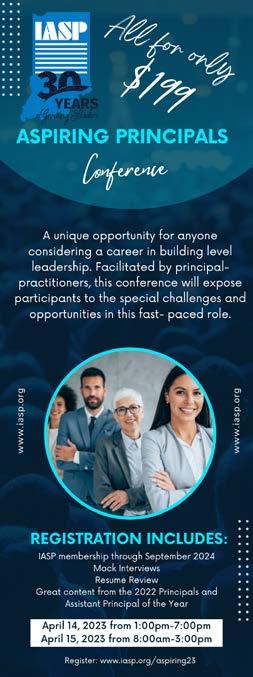
Thank you for all you do for students.
References
Cornell, D. G. (2020). Threat assessment as a school violence prevention strategy. Criminology & Public Policy, 19(1), 235-252.
Education Commission of the States. (2022, October). State profile – Indiana. https://reports.ecs.org/comparisons/view-by-state/812/IN
Indiana Department of Education. (n.d.). Indiana school safety specialist academy. https://www.in.gov/doe/students/school-safety-and-wellness/ training-opportunities/
Kelley, B., Brown, D., Peisach, L., & Perez, Z. (2022, October 5). 50-state comparison: K-12 school safety. Education Commission of the States https:// www.ecs.org/50-state-comparison-k-12-school-safety-2022/
National Center for Education Statistics. (2022). Safety and security practices at public schools. Condition of Education. U.S. Department of Education, Institute of Education Sciences. https://nces.ed.gov/programs/coe/indicator/ a19
Perez, Z. & Peisach, L. (2022, December 7). Trends and changes in approaches to school safety. EdNote https://ednote.ecs.org/trends-and-changes-inapproaches-to-school-safety/
Schaeffer, K. (2022, July 7). U.S. school security procedures have become more widespread in recent years but are still unevenly adopted. Pew Research Center https://www.pewresearch.org/fact-tank/2022/07/27/u-s-schoolsecurity-procedures-have-become-more-widespread-in-recent-years-but-arestill-unevenly-adopted/
Stanford, L. (2022, July 8). School crime and safety: What a decade of federal data show. EducationWeek https://www.edweek.org/leadership/schoolcrime-and-safety-what-a-decade-of-federal-data-show/2022/07
Special thanks to our Preferred Business Partner:

Return to Table of Contents
LEADERSHIP DEVELOPMENT
21 www.iasp.org
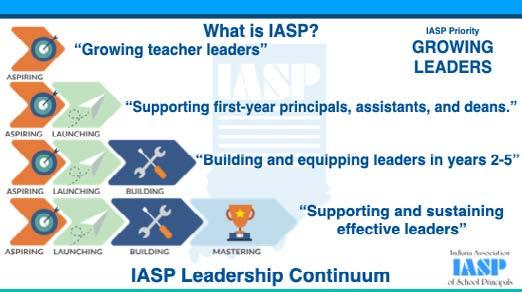
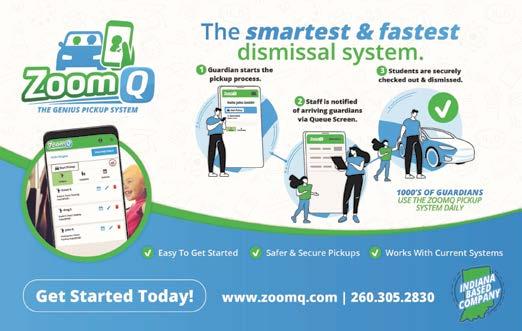
Return to Table of Contents 22 www.iasp.org
Meeting the Needs of Small/ Rural High Schools: The Rural Early College Network

 Dr. Janet Boyle Director Rural Early College Network
Dr. Janet Boyle Director Rural Early College Network

What do Rising Sun High School
(enrollment of 209, primarily Caucasian, students) and Logansport High School (enrollment of 1200 with 50% Latinx students) have in common? Both are members of the Rural Early College Network (RECN), a group of 20 rural IN high schools participating in a federal grant project.
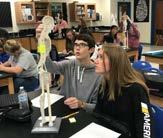
In 2019, the Center of Excellence or Leadership of Learning (CELL) was awarded a five-year EIR grant of $7.9 million to implement a network to serve small/rural high schools interested in launching Early College (EC) programs. The project rolled out with an initial ten schools, five which were designated as Mentor schools and the other five as Partner schools. Mentor schools were already endorsed by CELL as high quality EC high schools, and they were to assist CELL in coaching the Partner Schools. Mentor schools include Delta, Greensburg, Perry Central, Vincennes Lincoln, and Wabash. Partner schools were high schools interested in launching an EC and becoming endorsed. The first Partner schools included Jay County, Winchester, Parke Heritage, Bedford, and Logansport.
In the second year of the grant, five more schools joined as Partner schools–Rising Sun, Franklin County, New Palestine, Paoli, and Northridge. By the third year of the project, the remaining five Partner schools were selected and included Frontier, Sheridan, Shoals, Southridge, and Seeger.
RECN provides a structure of professional development, coaching on the Eight Core Principles of Early
College, and collaboration for all 20 schools. Each school has a School Leadership Team. Team members attend the RECN Network meetings for all 20 schools each semester. In addition, each Mentor school and its three Partner schools form a Quad, which meets once per semester. During these meetings, problems of practice are discussed and teams assist one another with implementation issues. Role-specific groups of teachers, counselors, and administrators also meet together during each meeting, and these tend to be the favorite sections of each meeting due to the rich conversations occurring.
CELL staff assist individual schools as needed and provide coaching. All RECN principals also participate in bimonthly Zoom meetings with CELL staff to plan meeting agendas and tackle issues and questions common to all. Schools have also organized meetings with other RECN schools that are the same enrollment size to discuss EC implementation.
Now in its fourth year, RECN has shown many positive results. Of the partner schools, nine of the fifteen have already achieved EC endorsement with five more going through the endorsement process yet this spring. All of the RECN schools have shared how their EC programs and practices have been improved for students and how their supports are now more targeted. Most RECN schools have created more visuals in their buildings to stress a college-going culture–displays, signage, boards depicting students’ dual credits earned, and in some cases, designated EC rooms or student lounges.
RECN has not only impacted these 20 high schools, but also CELL’s larger EC Network with improved outreach and professional development practices. CELL believes that Early College High Schools transform the lives of students and families and will continue to support this successful school model in our work across the state. As Dr. Jenner, our Hoosier Secretary of Education, states, “In order to maximize the outcomes for students, communities and our state, we must continue blurring the lines between K-12, higher education and workforce.” The staff at the Center of Excellence in Leadership of Learning couldn’t agree more!
Return to Table of Contents LEADERSHIP DEVELOPMENT
23 www.iasp.org
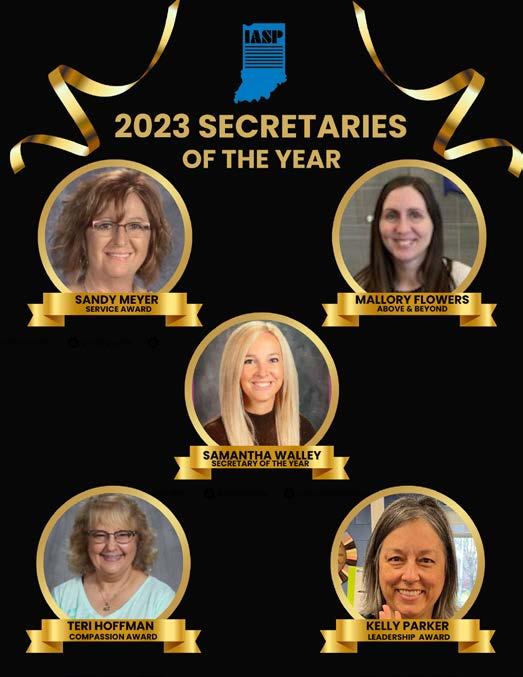
Return to Table of Contents 24 www.iasp.org

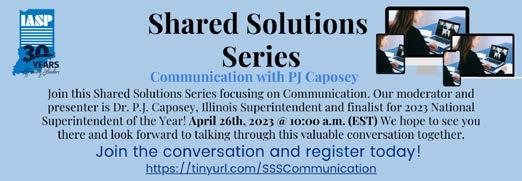





Return to Table of Contents
25 www.iasp.org
Special thanks to our University Partners:
IPLI Updates
Dr. Kelly Andrews Director Indiana Principal Leadership Institute

Safety
IPLI is a premier professional development opportunity for the practicing principals of Indiana. We are here to support you, encourage you, and provide growth in your leadership as we learn together, lead together, and connect.
We live in a world now where we are barraged daily with news reports of school incidents where the safety of students and school personnel is in jeopardy. We can no longer look at those reports and think that happens elsewhere. In the last twenty years, safety training offerings have intensified for school leaders so we can be prepared for what may/will happen in our spaces. Unfortunately, we are learning in real time from situations that occur regularly.
Students, families, and local communities often seek school leaders for guidance, support, decision-making, and management during a crisis. Communication and role responsibilities must be outlined for physical, emotional, and logistical crises. “Following a disaster, school leaders are required to extend their leadership beyond educational leadership to dealing with an immediate crisis, managing their schools as post-disaster community hubs, rebuilding the fabric of their school communities and all the while being sensitive to the physical, emotional, social, and psychological need of their staff, students and families” (Mutch, 2015a, p102).
From weather issues to global pandemics, crisis management is crucial to the principal’s role in today’s schools. We can be grateful for those in the field who bring the most up-to-date opportunities to learn and prepare for what may be a worst-case scenario.
IPLI is celebrating a decade of support for the principals of Indiana. With bi-partisan support from the Indiana General Assembly, IPLI was signed into law in 2013. After a decade of service, over 550 principals and schools have been supported by the IPLI conceptual model developed and the curriculum implemented to grow leaders and schools throughout Indiana.
Principals continue to lead and are vital to the success of our Indiana students. We are grateful for their leadership as they are learning leaders, leading learners! Wishing everyone a continued safe and healthy school year.
IPLI Seminars

In April 2023, IPLI will enjoy learning with the AR Showcase for Cohort 10, where principals will share their action research projects. Dr. Steve Gruenert will share Culture Rewired in the afternoon.
IPLI will celebrate Cohort 9 as their teams will share their action research for schools in the morning and graduate in the afternoon after hearing Annette Breaux as the keynote speaker on the Seven Simple Secrets. We anticipate a great two days of learning and sharing.
IPLI began in July 2013 and is excited to celebrate a decade of learning together. Cohort 11 will kick off a new decade of principals learning together, starting in July 2023, with keynote speaker Dr. Peter DeWitt as he shares Leader Self-Efficacy. Applications can be found on the IPLI website at www.indianapli.org and are due by March 15, 2023, for consideration. IPLI looks forward to serving Indiana principals by growing leaders and improving schools.
IPLI Extended enjoyed three great seminars under the theme, Leadership in Times of Change. Now, IPLI Extended is looking for input from all IPLI graduates, that will inform us as we move forward on your behalf. Please consider sharing your thoughts about IPLI Extended by taking this quick online survey: https://indstate.qualtrics.com/jfe/form/SV_1Nf7gSdNiKt24Oa
Our 23-24 school year theme will be “Leaders in Action!” Applications for the 23-24 Extended year will be available in late March.
Let’s keep learning together as we continue to lead in 2023!
References
Mutch, C. (2015a). Leadership in times of crisis: Dispositional, relational and contextual factors influencing school principal’s actions. International Journal of Educational Development, 41, 283-29.
Return to Table of Contents LEADERSHIP DEVELOPMENT
26 www.iasp.org
Riley Kids Caring & Sharing Update
Susan Miles Officer, Kids Caring & Sharing TM Riley Children’s Foundation

Could not do it without you!
I’m excited to share that the pediatric research team connected to Riley Children’s Health had another record year and continues to distinguish itself as one of the top 10 children’s research programs in the country!
The Department of Pediatrics at Indiana University School of Medicine – a partnership with Riley Children’s – is ranked 7th in the nation, according to new rankings from the Blue Ridge Institute for Medical Research. The IU/Riley program is the only nationally ranked pediatric research program in Indiana and the top-ranked program in the Midwest.
The Blue Ridge Institute bases its rankings on funding awarded by the National Institutes of Health. NIH grants are among the most competitive in the country and are commonly viewed as a barometer of research excellence. For the federal fiscal year that ended in September, IU/Riley physicians and scientists received a record $38 million from the NIH – a 9 percent increase over the previous year.

We are proud of the role our school philanthropy partners play in supporting this success. Donor support allowed Riley Children’ Foundation to grant more than $12 million to the Riley research team this year. The funds provide flexibility so investigators can test promising ideas, gather preliminary data necessary to apply for grants, sustain research during lulls in funding, hire laboratory staff, purchase cutting-edge equipment, and move discoveries forward from the lab to clinical studies.
You can read more about some of the specific research projects underway at IU/Riley on the Foundation’s blog.
More amazing things you help make happen
Riley Children’s Health has the only fetal surgery program in Indiana, another specialized program supported through donor gifts. Fetal surgeons Hiba Mustafa, MD, and Dave Streitman, MD, started and developed the fetal intervention program at Riley just last year.
In October, their team performed the first twin-to-twin transfusion syndrome (TTTS) procedure in the state, and on February 16, Rebekah Koehn safely delivered two healthy baby girls at Riley. TTTS is a rare condition affecting identical twins or other multiples that occurs when twins share one placenta and a network of blood vessels that supply oxygen and nutrients, causing issues for one or both babies.
Your amazing Riley fetal surgeons performed the minimally invasive, lifesaving laser surgery in utero to correct the imbalance. Previously, patients had to leave Indiana to receive this type of procedure, but with the development of the fetal intervention program, these services are now closer to home.
Read more about the miracle delivery of the Koehn babies here.
A Riley Champion near you?
2023 Riley Champion Veronica Salrin shared her brave and amazing story with participants at November’s Fall Professional Conference and her fellow Champions were introduced in January’s Indianagram. Already this year I have been honored to recognize three Riley Champions within their own school communities with more Champion school celebrations set to follow this spring. It is a joy to see each Champion grow in their ambassadorship.
You may already know a 2024 Riley Champion – perhaps someone in your own school or school corporation who is turning their biggest challenge into their greatest strength. Before the end of the school year, please consider nominating a Riley patient from your community who demonstrates courage and commitment to helping others while navigating medical obstacles. https://rileykids.org/get-involved/nominate-a-rileychampion
Return to Table of Contents
SERVICE
27 www.iasp.org
KGR Law Briefing: Special Education Law Developments
Séamus Boyce Attorney Kroger Gardis & Regas, LLP

Special education law issues consistently come up in discussions with IASP members through the KGR Legal Help Desk (LHD). In particular, we have received many inquiries about how to handle specific incidents when an Individualized Education Plan (IEP) is in place. Below are recent examples of how Indiana federal courts have handled situations involving the Individuals with Disabilities Education Act (IDEA)(commonly referred to by the Indiana version in regulation, 511 IAC 7 or “Article 7”).
Novit v. MSD Warren Township.
This case concerns a student who had a seizure on the bus ride home. At the time of the seizure, no personnel present knew how to administer the student’s seizure action plan. The student suffered neurological injuries and personal injuries because of the incident and sued the school seeking damages under the Individuals with Disabilities Education Act (IDEA).
The school asked the court to dismiss the student’s complaint regarding their IDEA claim. The school argued the student needs to exhaust administrative remedies before suing in court, consistent with Fry v. Napoleon Community Schools. The family believed they should not have to exhaust the administrative process as it would be futile to do so.
The court sided with the school because the student’s complaint hinged on the IDEA. First, parts of the complaint cite violations of the IDEA. Secondly, the inexperienced care at issue falls under IDEA violations. Finally, the complaint would not cover inexperienced care in another public
To listen to this brief, click HERE!
area such as a theater. The right at issue concerned the student’s statutory right to a free appropriate public education with personnel that can properly help him with his disability, all subject to the IDEA and its exhaustion requirement.
While this case sounds fairly technical, it is an important one to give peace of mind to school leaders that think they will constantly be sued for monetary damages. While the IDEA does tend to lead to a lot of disputes, families must go through the administrative dispute resolution process before going to court.
T.Z. by and through P.Z. v. Tippecanoe School Corporation
This second case opinion was just recently decided in late January 2023. It concerns a special education student with a severe anxiety disorder and an Individualized Education Plan (IEP) that allowed for “time outs.” However, the school staff would regularly place the child in a windowless area for time out sessions. This isolation period could last for upwards of an hour without the child being monitored. The student was also away from classmates by being kept from recess and activities unless he had displayed proper social behavior. The family alleged the student was punished because of his disability, as other non-disabled students would not be subjected to the same treatment. In addition to this case, the student filed an administrative complaint with the Department of Education regarding improper execution of the child’s IEP under the IDEA. The student, however, did not make an IDEA claim in their federal lawsuit.
The school argued under precedent
established by the previously cited Fry that the student did not exhaust administrative remedies before filing in federal court and thus the case should be dismissed. The court allowed the litigation to continue because the crux of the student’s argument is the district violated his rights distinctly “from inadequate individualized educational services” that would be at issue for an IDEA violation. In addition, the court was persuaded that if the child had been in another public facility and was isolated in a closet for his disability, he could very likely bring a lawsuit and bypass the administrative complaint process.
Unlike the first case that was required to be addressed through the IDEA dispute resolution process, the second case has the type of fact pattern that can go around those dispute resolution requirements. A lesson learned from comparing these cases is not to rely on “administrative exhaustion” requirements for special education situations. Even if you implement an IEP with fidelity, your acts and omissions can still damage a student and lead to costly litigation. Therefore, you must: (1) develop an appropriate IEP; (2) implement the IEP; AND (3) act with reasonable care when addressing the needs of a student. When in doubt in any situation, take a step back and observe the situation as if you were a third party. If the optics are not good, then you probably need to rethink your approach.
We at the KGR Legal Help Desk are here to address legal issues for IASP members. Until the next KGR Law Briefing, stay legal!
Return to Table of Contents LEGAL REVIEW
28 www.iasp.org
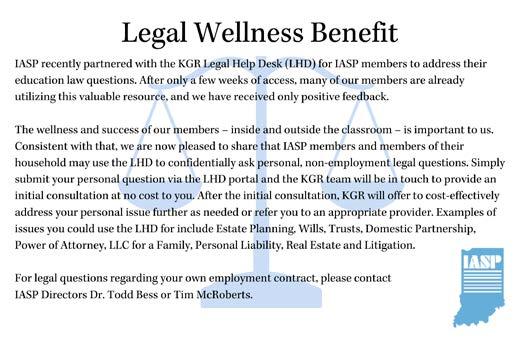

Return to Table of Contents LEGAL REVIEW 29 www.iasp.org
1-800-285-2188 or 317-891-9900


|
your partner
Financial wellness, one of the biggest challenges for employees, is defined as, “being confident in your financial situation, able to withstand unexpected expenses and enjoy a financially secure future.”1

Employees have many financial needs — meeting everyday expenses, paying off debt, saving for emergencies, paying for healthcare and saving for retirement — but there’s only so much money to go around.
A well-crafted financial wellness program may be the answer. No matter where your employees are in their journey, Horace Mann will be with them every step of the way. Contact your local Horace Mann represenative today to learn more or schedule a workshop.
Horace Mann has been helping your employees with financial wellness since 1945
Horace Mann constitutes official action for purposes of student loan forgiveness programs or guaranteed results. Horace Mann is not affiliated with state teachers’ retirement systems, and the content of its workshops has not been endorsed or approved by state teachers’ retirement systems. AM-C04711 (2-23)
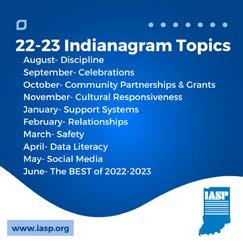
11025 East 25th Street Indianapolis, IN 46229
www.iasp.org
iasp-info@iasp.org Horace Mann is
in financial wellness horacemann.com 1LIMRA, “A Measure of Financial Wellness” 2020 The information provided here is for general informational purposes only, and should not be considered a recommendation or investment, tax or legal advice. DonorsChoose is not an affiliate of Horace Mann. Horace Mann Life Insurance Company underwrites Horace Mann life insurance products. Horace Mann’s Student Loan Solutions program includes services provided by an independent third party, Tuition.io. Horace Mann is an independent company not affiliated with the Department of Education or the federal government. No assistance provided by
Connect with us @INPrincipals


 Matt Shockley IASP President
Matt Shockley IASP President





 Dr. Katie Jenner Indiana Secretary of Education
Dr. Katie Jenner Indiana Secretary of Education


























 Dr. Janet Boyle Director Rural Early College Network
Dr. Janet Boyle Director Rural Early College Network














